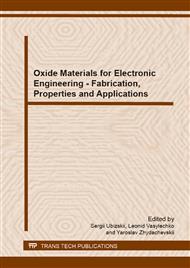p.33
p.38
p.45
p.50
p.54
p.60
p.69
p.73
p.79
Mechanical Properties of Free-Standing Porous Anodic Alumina Films
Abstract:
The flexural strength and microhardness of free-standing anodic alumina films obtained from the one-sided anodization of aluminum are discussed. The films formed of high-pure aluminum were shown to have maximum flexural strength. Even a small amount of impurities decreases the flexural strength of the resulting free-standing anodic alumina films to be associated with their higher defectiveness. The microhardness of thick films of anodic alumina measured on the side of a barrier layer is independent of the film thickness, and this measured on the side of the porous layer decreases continuosly from 5.39-5.88 GPa to 2.94 GPa when the film thickness increases from 50 to 500 μm. The microhardness of thin (<100 μm) films of porous anodic alumina was studied as well. When the samples were immovable in the electrolyte during the anodization, the microhardness of the resulting films is low and varies from 0.93 to 1.86 GPa. When the samples moved in the electrolyte occasionally during the anodization, the microhardness of the resulting films increases to 1.67 – 2.45 GPa. When the samples moved in the electrolyte continuously during the anodization, the microhardness of the resulting films increases to 2.45 - 3.43 GPa. This is associated with the rate of the heat removal from the sample (the oxidation rate) during the anodization. The microhardness of the free-standing porous anodic alumina films formed of low binary alloys of aluminum is lower than one of films formed of high-pure aluminum.
Info:
Periodical:
Pages:
54-59
Citation:
Online since:
April 2013
Authors:
Price:
Сopyright:
© 2013 Trans Tech Publications Ltd. All Rights Reserved
Share:
Citation:


